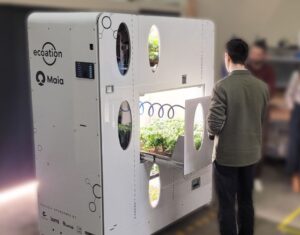This week I took part in NYC AgTech Week, a week-long event that attracted indoor agriculture enthusiasts from across the globe for a series of presentations, tours, and panel discussions. On Tuesday evening, indoor ag software startup Agrilyst hosted a panel discussion on funding for indoor farms and other agtech startups.
For an area of agtech that gets so much hype, if AgFunderNews click rates are anything to go by, we are always amazed at the relatively low volumes of funding that go into it. In 2015, indoor agriculture startups — encompassing physical indoor farms and any hardware or software products serving them — raised $77 million, and during the first half of this year that figure was just $21 million. That’s from a total $4.6 billion in agtech investment in 2015 and $1.8 billion in the first half of 2016.
Having said that, the subsector has captured some of agtech’s largest deals, and this week’s $30 million Series C from BrightFarms is no exception. BrightFarms says this is the largest equity funding round for a US indoor ag company. The largest deal on record was 2014’s $100 million investment from private equity behemoth KKR into Sundrop Farms, the Australian greenhouse project. New Jersey-based vertical farming group AeroFarms has also raised big money, with Goldman Sachs and Prudential contributing $40 million to a $70 million debt financing for a specific farm project last year and the company has raised more in equity funding for the business too.
These deals are so big because scaling an indoor farming business is no small feat. The time it takes to do so is a big question for venture capital firms and has kept many away, argued James Smits from Beta Bridge Capital, who was speaking on the panel. Venture capital investors typically want to hold investments for around five years, but scaling an indoor farming company could take at least that time.
Beta Bridge, which focuses on seed stage investments, is instead accessing the indoor ag market through software and invested in Agrilyst’s seed round earlier this year. Agrilyst is likely to behave a lot like any other SaaS platforms in Smits’ portfolio and very different from asset-heavy indoor farming businesses.
There are of course some VCs that have invested in indoor farming startups, and the main players all have VCs in their investor line-up. It’s particularly suitable at the growth stage, such as Catalyst Investors in BrightFarms’ latest round. In this case, BrightFarms has de-risked its business model with proven technology in existing facilities and long-term produce purchase agreements with grocery making it a very different proposition to investing in a startup indoor farm with little operating history.
So where should startup indoor farms look for early stage funding? If you look at the investor base of indoor farms so far, you’ll notice there’s actually a very broad range of investors available to the sector, including family offices and impact investors. They may have longer investment time horizons and missions than a typical VC, and so can stick with the business through the early stages and into growth.
Regional investors are another potential source of funding such as NYS Innovation Venture Capital Fund, a New York state-funded vehicle, which is looking closely at the agtech space. Speaking on the panel from the fund, Lindsay Freeman Avagliano said that the fund’s mission was to make a positive impact on communities in New York through funding local innovation. The relatively new fund, which has $100 million to deploy, will reserve follow-on funding for the majority of investments it makes, she told the audience.
Then there are other routes altogether, namely project financing and debt for specific initiatives like the Goldman Sachs deal. This funding can be longer term and support the construction of facilities and purchase of equipment — instead of providing equity funding for a startup’s general overheads.
Speaking to this on the panel was Angela Ferrante from SparkFund, which offers loans to businesses to purchase energy efficient tools for their businesses, and has loaned to indoor farms to purchase LED lighting. This is a novel way of getting access to the equipment you need without giving away equity.
There’s also the crowdfunding route, which is a great way to find mission-oriented individual investors, who are passionate about the space.
So while venture capital might not always make sense for indoor ag startups, there are other options for startups to consider.
What do you think? Where do you think indoor farming startups should seek funding? Get in touch [email protected].
















Sponsored
International Fresh Produce Association launches year 3 of its produce accelerator